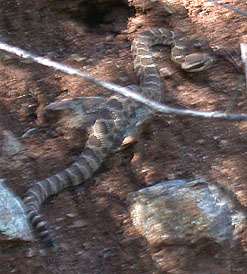|
|
|
|
|
|
|
|
|
|
|
|
|
|
|
|
|
|
|
|
|
|
|
|

|
|
|
|
|
|
|
|
|
|
|
|
|
|
|
|
|
|
|
|
|
|
|
|
|
|
|

|
|
|
It is spring and the woods are full of flowers...and rattlesnakes. This time of year they move alot and hunt actively. There's also ticks and poison oak in abundance right now.

A good way to avoid Rattlesnakes is to avoid the habitat that they prefer. Logpiles and rockpiles are places Rattlesnakes love to inhabit. If you are always careful around these spots, chances are you will see the snake in plenty of time to avoid a strike.
When going over logs, step up onto the log and then far over it. Snakes frequently lie along logs, and if you simply step over one, you may be putting your foot right down on top of a Rattler- not good! Most snakebites result from stepping on or handling snakes.
If you are forced to travel through thick brush or high grass, you may encounter a snake, especially in the Springtime when they are more actively travelling and feeding. Be sure you have a walking staff to thump the ground and probe the way in front of you. This way you alert the Rattler to your coming, and most of the time it would prefer to get out of your way. If it starts crawling your way- a very scary situation- you can turn it aside with your stick. I have had a rattlesnake hear me coming by thumping my stick and it rattled in warning.
Gaiters are a good thing to wear in snake country. My friend, Marty, has hunted in a snake-infested area, and tells me that twice he felt a bump on his leg or ankle and looked down to see a dent in the gaiters where a rattler had tried to bite. Neither snake rattled a warning.
I have read about the Sawyer Extractor being an effective method of removing some of the poison from a bite if applied within the first ten minutes. I have also heard about electrical shocking with a car battery and jumper cables applied to the bite site. This is supposed to neutralize the poison, but it hasn't been scientifically tested. I suppose its hard to get volunteers to be rattlesnake bit.
What you are SUPPOSED TO DO in the event of Rattlesnake bite is to lie still, put a constricting band- not a tourniquet- above the bite and wait for help to take you to the hospital where they can inject antivenin. This is not always possible if you are a long ways outback and possibly alone.
I went out a couple of days after a spring rain. I sat down in a grassy glade to rest and every two minutes I was picking a tick off of my clothing, or hair, or neck. It was positively maddening. I was going to camp overnight, but I could just see getting up from sleeping on the ground the next morning and having to dig 50 ticks out of my skin! I left the mountains a went by to see an old friend. While sitting on his couch and talking for an hour I pulled more than a dozen more ticks off of myself, and even stood up to find one crawling over the couch. YUCK!
Needless to say, I was going to include bug spray containing a high concentration of DEET to with my necessities for my next outing. But it got me thinking about what a sudden survivor in the wilderness, or the Indians would do to keep pests away.
Fire is a good pest deterrent, or rather the smoke from the fire. Add to that the smoke from any non-poisonous, aromatic leaves, like pine needles or California Bay Laurel. Then jump back and forth across the fire pit several times, keeping your eyes closed so the smoke won't sting them. This will coat you with the oils from the leaves.